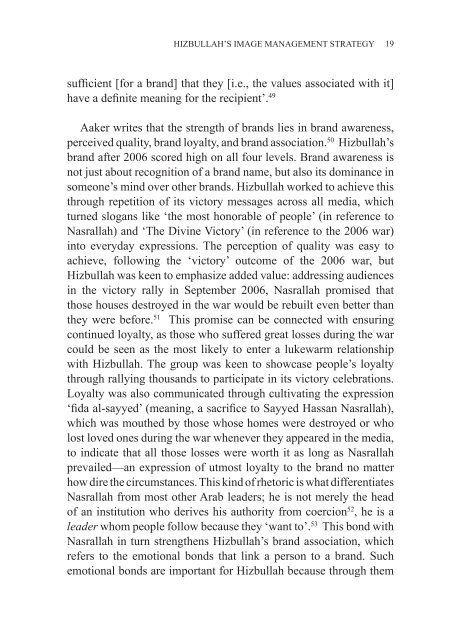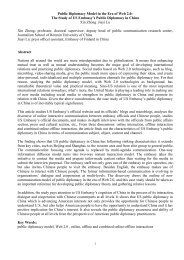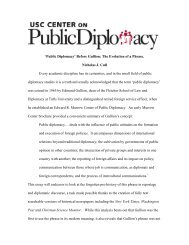Hizbullah's Image Management Strategy - USC Center on Public ...
Hizbullah's Image Management Strategy - USC Center on Public ...
Hizbullah's Image Management Strategy - USC Center on Public ...
Create successful ePaper yourself
Turn your PDF publications into a flip-book with our unique Google optimized e-Paper software.
HIZBULLAH’S IMAGE MANAGEMENT STRATEGY<br />
19<br />
sufficient [for a brand] that they [i.e., the values associated with it]<br />
have a definite meaning for the recipient’. 49<br />
Aaker writes that the strength of brands lies in brand awareness,<br />
perceived quality, brand loyalty, and brand associati<strong>on</strong>. 50 Hizbullah’s<br />
brand after 2006 scored high <strong>on</strong> all four levels. Brand awareness is<br />
not just about recogniti<strong>on</strong> of a brand name, but also its dominance in<br />
some<strong>on</strong>e’s mind over other brands. Hizbullah worked to achieve this<br />
through repetiti<strong>on</strong> of its victory messages across all media, which<br />
turned slogans like ‘the most h<strong>on</strong>orable of people’ (in reference to<br />
Nasrallah) and ‘The Divine Victory’ (in reference to the 2006 war)<br />
into everyday expressi<strong>on</strong>s. The percepti<strong>on</strong> of quality was easy to<br />
achieve, following the ‘victory’ outcome of the 2006 war, but<br />
Hizbullah was keen to emphasize added value: addressing audiences<br />
in the victory rally in September 2006, Nasrallah promised that<br />
those houses destroyed in the war would be rebuilt even better than<br />
they were before. 51 This promise can be c<strong>on</strong>nected with ensuring<br />
c<strong>on</strong>tinued loyalty, as those who suffered great losses during the war<br />
could be seen as the most likely to enter a lukewarm relati<strong>on</strong>ship<br />
with Hizbullah. The group was keen to showcase people’s loyalty<br />
through rallying thousands to participate in its victory celebrati<strong>on</strong>s.<br />
Loyalty was also communicated through cultivating the expressi<strong>on</strong><br />
‘fida al-sayyed’ (meaning, a sacrifice to Sayyed Hassan Nasrallah),<br />
which was mouthed by those whose homes were destroyed or who<br />
lost loved <strong>on</strong>es during the war whenever they appeared in the media,<br />
to indicate that all those losses were worth it as l<strong>on</strong>g as Nasrallah<br />
prevailed—an expressi<strong>on</strong> of utmost loyalty to the brand no matter<br />
how dire the circumstances. This kind of rhetoric is what differentiates<br />
Nasrallah from most other Arab leaders; he is not merely the head<br />
of an instituti<strong>on</strong> who derives his authority from coerci<strong>on</strong> 52 , he is a<br />
leader whom people follow because they ‘want to’. 53 This b<strong>on</strong>d with<br />
Nasrallah in turn strengthens Hizbullah’s brand associati<strong>on</strong>, which<br />
refers to the emoti<strong>on</strong>al b<strong>on</strong>ds that link a pers<strong>on</strong> to a brand. Such<br />
emoti<strong>on</strong>al b<strong>on</strong>ds are important for Hizbullah because through them











